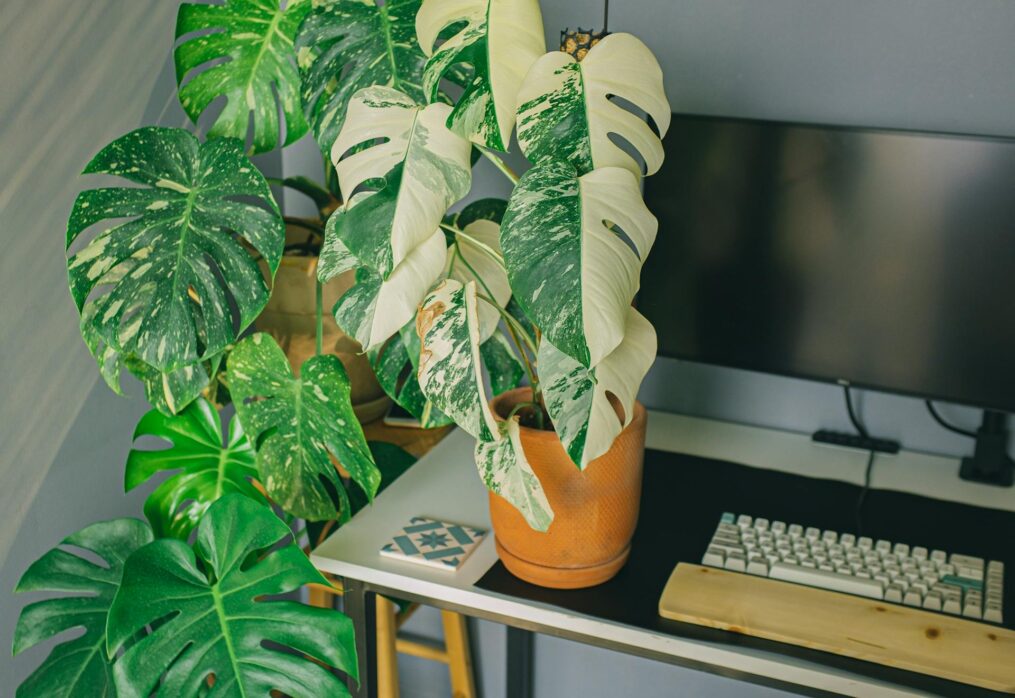5 gorgeous variegated plants to bring home
Nurturing indoor plants can be a fulfilling pastime. Plants offer numerous health advantages, such as purifying the air, reducing stress, and promoting better sleep. For those who are passionate about plants and have a wide collection of pothos and philodendron, adding indoor variegated plants can bring a fresh visual appeal to their home. These varieties are among the top choices for houseplants.
What do variegated plants refer to?
First, let’s explore the meaning of “variegated” in relation to houseplants. Variegated plants display leaves with different colors, often combining one solid color like green with another accent color. Exploring various color combinations with contrasting shades of green like emerald and lime, along with yellow, pink, red, purple, and white in patterns that vary from random sections to stripes, blotches, spots, and borders. Variegated plants typically display two colors, but certain varieties can exhibit three or more colors on a single leaf. Observing the colors and patterns on a plant with variegated leaves can reveal variations based on light exposure and the season.
What leads to variegation?
Variegated plants: hand-holding leaves The wide variation in the color of plant leaves occurs due to a lack of chlorophyll in some of the plant’s cells. Chlorophyll contains the pigment that gives plants their green color. There are three main causes of chlorophyll deficiency: genetic mutation, viral infection, and natural variegation. Genetic mutation: A cell mutation can occur as a genetic mutation or as a random mutation, known as a chimeric gene. Genetic mutations indicate that a plant’s color is stable and that its offshoots will also carry this genetic mutation, whether that is a solid color like red or purple or a variegation. A chimeric mutation is unstable, which means that if a new plant is propagated from a variegated one, only cuttings from variegated shoots will carry the new trait. Otherwise, new plants will not feature the variegation. Viral infection: Although a fairly rare form of variegation, it is possible for plants to have discolored leaves or veins as the result of a viral infection. Like a genetic mutation, this is considered a stable variation. Natural variegation: Some plants produce variegated leaf colors because of a pattern gene present in the plant’s DNA. This can be a result of years of adaptation to survive in the wild. In some cases, variegation gives plants an advantage over other green varieties.
Why Plants Lose Their Variation
A variegated plant that has a stable genetic mutation will continue to produce offshoots of plants that also display this genetic mutation. Sometimes, especially among fast-growing houseplants, they may revert to a solid color. This is often caused by insufficient light. Variegated plants with an unstable mutation will eventually revert back to solid-green plants. This is a technique some plants rely on to get enough chlorophyll to survive. Unstable mutations are generally less common because a lack of chlorophyll lowers a plant’s chance for survival in nature.
Tips for Caring for Variegated Plants
Many indoor variegated plants come from tropical environments, so they’re often grown in greenhouses where temperature and humidity are maintained at an optimum level. If having an indoor grow house isn’t desirable or feasible, though, there are several ways to give your variegated houseplants the right amounts of light and humidity. For plants in a room lacking the bright, indirect light many houseplants love (as well as during the winter), consider supplementing that light with grow lights. A lack of light can cause a plant’s variegation to fade as it tries to produce more chlorophyll-absorbing cells. Keep a hand mister around to regularly spray plants or add a humidifier to the room. Note that many indoor variegated plants are sensitive to direct sunlight. Provide bright, indirect light for most houseplants, unless a specific plant needs more or less light. Remove solid-green offshoots to maintain the variegation; once the plant produces fully green foliage, it will continue to do so in an attempt to get as much energy as it can. Pair interesting variegated plants with indoor flowering houseplants such as orchids for a beautiful tropical vibe.
1. Variegated String of Hearts (Ceropegia woodii)
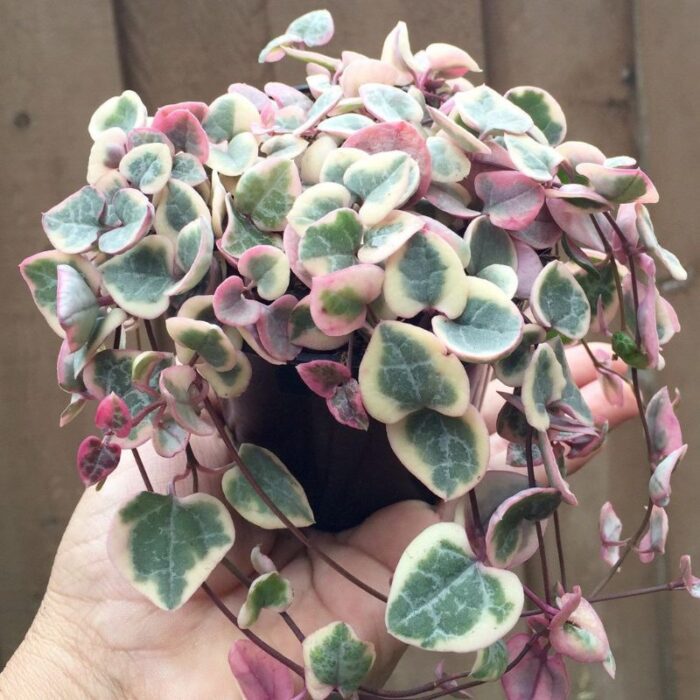 Sometimes called the rosary vine, this plant gets its name from the tiny, heart-shaped leaves that appear spaced out along the vines. It’s semi-succulent, so it’s best to let it dry out completely between waterings. The variegated leaves are pale green with silvery veins and edges tinged pink or even purple. It also blooms (mostly in summer and fall) with interesting, upright, tubular pink flowers. Give it bright indirect light.
Sometimes called the rosary vine, this plant gets its name from the tiny, heart-shaped leaves that appear spaced out along the vines. It’s semi-succulent, so it’s best to let it dry out completely between waterings. The variegated leaves are pale green with silvery veins and edges tinged pink or even purple. It also blooms (mostly in summer and fall) with interesting, upright, tubular pink flowers. Give it bright indirect light.
2. Snake Plant (Dracaena trifasciata) Variegated Plants: Snake Plant
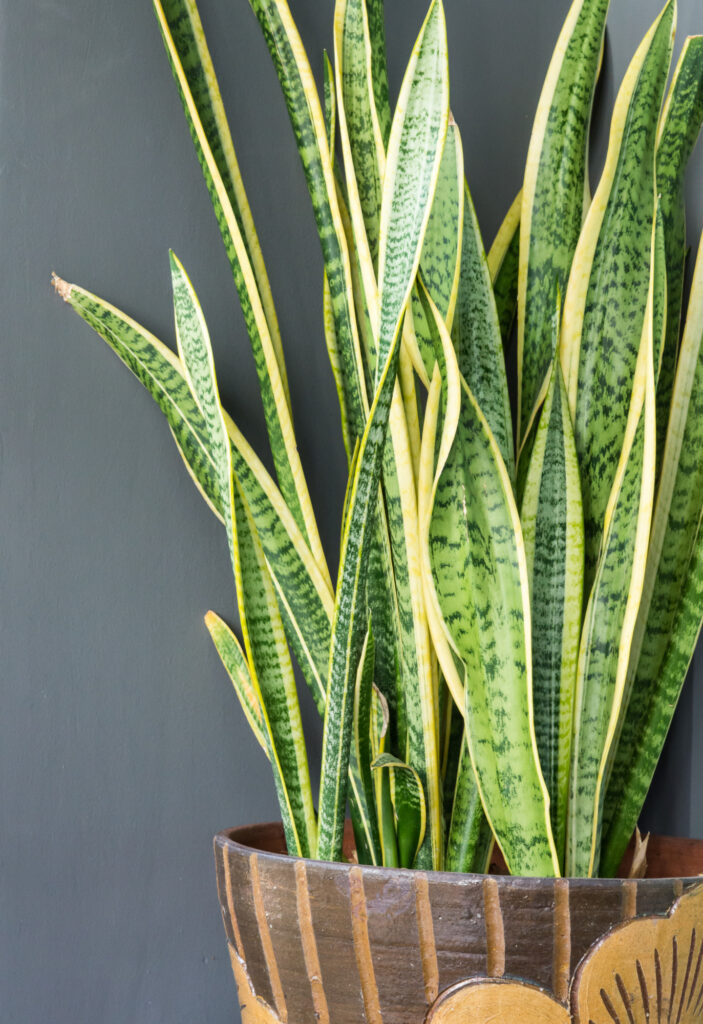 Quite possibly one of the easiest and most forgiving houseplants, all varieties of snake plants are low-maintenance and can tolerate medium to low light as well as infrequent waterings. This variety has deep green leaves striped with yellow edges. If a snake plant is listed for purchase as Sansevieria trifasciata, it is one and the same; this plant was classified as such until very recently.
Quite possibly one of the easiest and most forgiving houseplants, all varieties of snake plants are low-maintenance and can tolerate medium to low light as well as infrequent waterings. This variety has deep green leaves striped with yellow edges. If a snake plant is listed for purchase as Sansevieria trifasciata, it is one and the same; this plant was classified as such until very recently.
3. Red Congo Philodendron (Philodendron ‘Congo Rojo’)
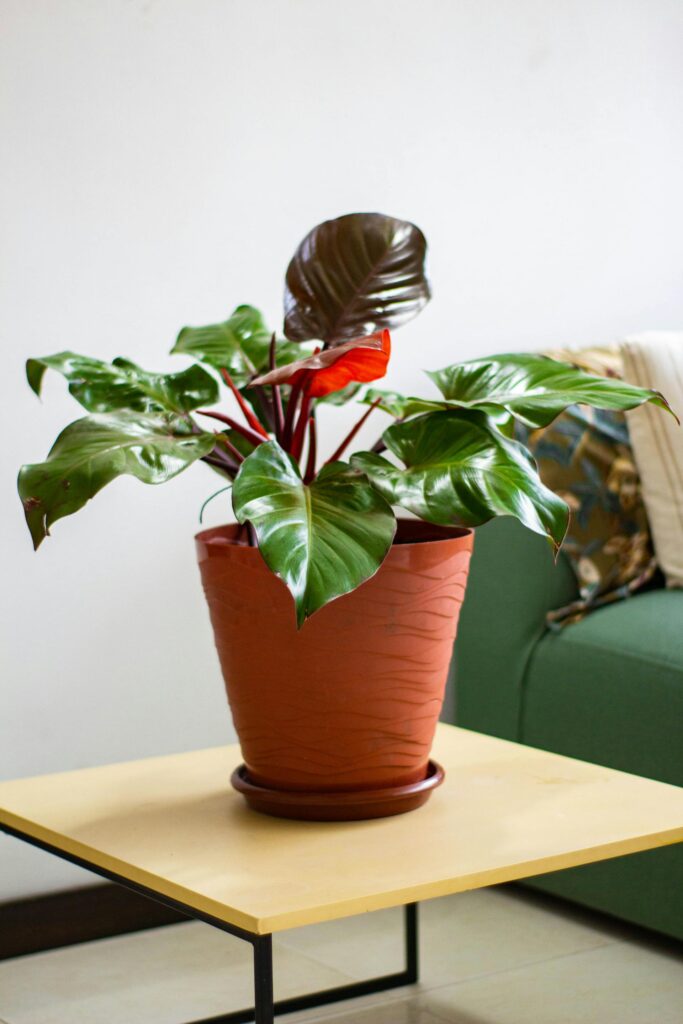 A true centerpiece of any room, the Red Congo Philodendron features long green leaves that can be variegated with deep emeralds, contrasting with shades of white, pink, and even reddish-orange. The stems of this philodendron variety are a deep red color. The plants prefer bright light and even a little morning sunlight, regular water, and consistent humidity.
A true centerpiece of any room, the Red Congo Philodendron features long green leaves that can be variegated with deep emeralds, contrasting with shades of white, pink, and even reddish-orange. The stems of this philodendron variety are a deep red color. The plants prefer bright light and even a little morning sunlight, regular water, and consistent humidity.
4. Variegated Monstera (Monstera deliciosa)
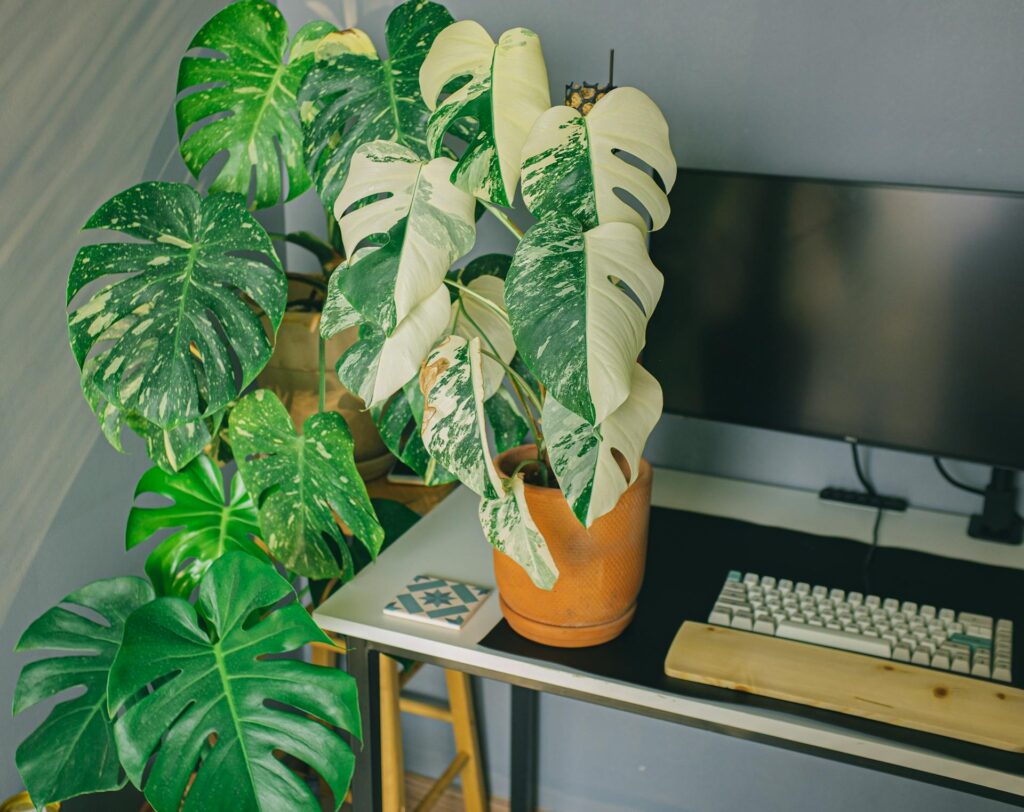 Several species of monsteras have variegated leaves, usually in shades of green, white, and yellow. Monstera deliciosa ‘Thai Constellation’ is one of the most reliable, with white and pale yellow patterns on nearly every leaf. Aurea features similar patterns but with a brighter yellow. The true Monstera deliciosa ‘Variegata’ plant is the result of a genetic mutation and is rarely sold since it can mutate back to a standard green monstera. All varieties love bright light, humidity, and warm indoor temperatures.
Several species of monsteras have variegated leaves, usually in shades of green, white, and yellow. Monstera deliciosa ‘Thai Constellation’ is one of the most reliable, with white and pale yellow patterns on nearly every leaf. Aurea features similar patterns but with a brighter yellow. The true Monstera deliciosa ‘Variegata’ plant is the result of a genetic mutation and is rarely sold since it can mutate back to a standard green monstera. All varieties love bright light, humidity, and warm indoor temperatures.
5. Prayer Plant (Maranta leuconeura)
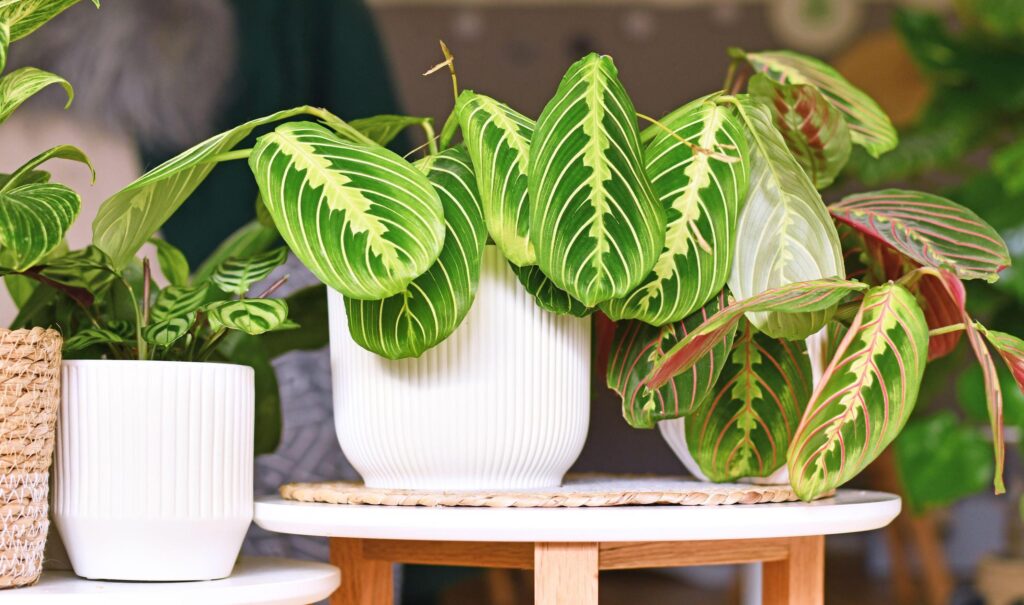 One of the more unique houseplants, the Prayer Plant, is named for the fact that the leaves curl up at night, as if in prayer. The consistent variegation of the leaves includes red veins against two-tone, velvety green leaves with a purple underside (visible when they curl up). It is semi-vining and makes a great hanging basket plant as it gets older. Give it indirect, bright light, regular water, and plenty of humidity. I recommend checking out:
One of the more unique houseplants, the Prayer Plant, is named for the fact that the leaves curl up at night, as if in prayer. The consistent variegation of the leaves includes red veins against two-tone, velvety green leaves with a purple underside (visible when they curl up). It is semi-vining and makes a great hanging basket plant as it gets older. Give it indirect, bright light, regular water, and plenty of humidity. I recommend checking out:
Last Updated on 1 year ago by Anjali Mehra Ph.D. in Horticulture (Punjab Agricultural University)
- Why Lawn Grass Fails After Installation (Real Indian Case Studies) - December 25, 2025
- Nilgiri Grass vs Korean Grass – Price, Look & Maintenance Compared - December 23, 2025
- Delhi Pollution & Dust-Proof Lawn Care Guide - December 20, 2025
